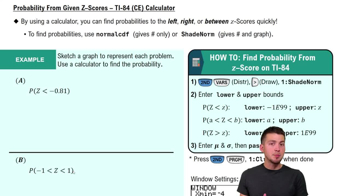Family/Partner Groups of people aged 15–65 are randomly selected and arranged in groups of six. The random variable x is the number in the group who say that their family and/or partner contribute most to their happiness (based on a Coca-Cola survey). The accompanying table lists the values of x along with their corresponding probabilities. Does the table describe a probability distribution? If so, find the mean and standard deviation.
Table of contents
- 1. Intro to Stats and Collecting Data1h 14m
- 2. Describing Data with Tables and Graphs1h 55m
- 3. Describing Data Numerically2h 5m
- 4. Probability2h 16m
- 5. Binomial Distribution & Discrete Random Variables3h 6m
- 6. Normal Distribution and Continuous Random Variables2h 11m
- 7. Sampling Distributions & Confidence Intervals: Mean3h 23m
- Sampling Distribution of the Sample Mean and Central Limit Theorem19m
- Distribution of Sample Mean - Excel23m
- Introduction to Confidence Intervals15m
- Confidence Intervals for Population Mean1h 18m
- Determining the Minimum Sample Size Required12m
- Finding Probabilities and T Critical Values - Excel28m
- Confidence Intervals for Population Means - Excel25m
- 8. Sampling Distributions & Confidence Intervals: Proportion1h 12m
- 9. Hypothesis Testing for One Sample3h 29m
- 10. Hypothesis Testing for Two Samples4h 50m
- Two Proportions1h 13m
- Two Proportions Hypothesis Test - Excel28m
- Two Means - Unknown, Unequal Variance1h 3m
- Two Means - Unknown Variances Hypothesis Test - Excel12m
- Two Means - Unknown, Equal Variance15m
- Two Means - Unknown, Equal Variances Hypothesis Test - Excel9m
- Two Means - Known Variance12m
- Two Means - Sigma Known Hypothesis Test - Excel21m
- Two Means - Matched Pairs (Dependent Samples)42m
- Matched Pairs Hypothesis Test - Excel12m
- 11. Correlation1h 6m
- 12. Regression1h 50m
- 13. Chi-Square Tests & Goodness of Fit1h 57m
- 14. ANOVA1h 57m
5. Binomial Distribution & Discrete Random Variables
Discrete Random Variables
Problem 5.3.7a
Textbook Question
In Exercises 5–8, assume that the Poisson distribution applies; assume that the mean number of Atlantic hurricanes in the United States is 5.5 per year, as in Example 1; and proceed to find the indicated probability.
a. Find the probability that in a year, there will be no hurricanes.
 Verified step by step guidance
Verified step by step guidance1
Step 1: Recall the formula for the Poisson probability distribution: P(X = k) = (λ^k * e^(-λ)) / k!, where λ is the mean number of occurrences, k is the number of occurrences we are interested in, and e is the base of the natural logarithm (approximately 2.718).
Step 2: Identify the given values from the problem. Here, λ = 5.5 (the mean number of hurricanes per year) and k = 0 (since we are finding the probability of no hurricanes in a year).
Step 3: Substitute the values into the Poisson formula. This gives P(X = 0) = (5.5^0 * e^(-5.5)) / 0!.
Step 4: Simplify the terms in the formula. Note that any number raised to the power of 0 is 1, so 5.5^0 = 1. Also, 0! (zero factorial) is equal to 1. Therefore, the formula simplifies to P(X = 0) = (1 * e^(-5.5)) / 1.
Step 5: The final step is to compute e^(-5.5) and divide by 1 to find the probability. This step involves using a calculator or software to evaluate the exponential term.
 Verified video answer for a similar problem:
Verified video answer for a similar problem:This video solution was recommended by our tutors as helpful for the problem above
Video duration:
2mPlay a video:
Was this helpful?
Key Concepts
Here are the essential concepts you must grasp in order to answer the question correctly.
Poisson Distribution
The Poisson distribution is a probability distribution that expresses the probability of a given number of events occurring in a fixed interval of time or space, given a known average rate of occurrence. It is particularly useful for modeling rare events, such as the number of hurricanes in a year, where the events are independent of each other.
Recommended video:
Guided course

Intro to Frequency Distributions
Mean (λ) in Poisson Distribution
In the context of the Poisson distribution, the mean (denoted as λ, lambda) represents the average number of occurrences of the event in the specified interval. For this question, λ is given as 5.5, indicating that, on average, there are 5.5 hurricanes per year in the United States.
Recommended video:
Guided course

Mean & Standard Deviation of Binomial Distribution
Calculating Probability with Poisson
To find the probability of observing a specific number of events in a Poisson distribution, the formula P(X=k) = (e^(-λ) * λ^k) / k! is used, where P(X=k) is the probability of k events occurring, e is Euler's number, and k! is the factorial of k. For this question, to find the probability of no hurricanes (k=0), you would substitute λ=5.5 and k=0 into the formula.
Recommended video:
Guided course

Probability From Given Z-Scores - TI-84 (CE) Calculator

 7:09m
7:09mWatch next
Master Intro to Random Variables & Probability Distributions with a bite sized video explanation from Patrick
Start learningRelated Videos
Related Practice
Textbook Question
